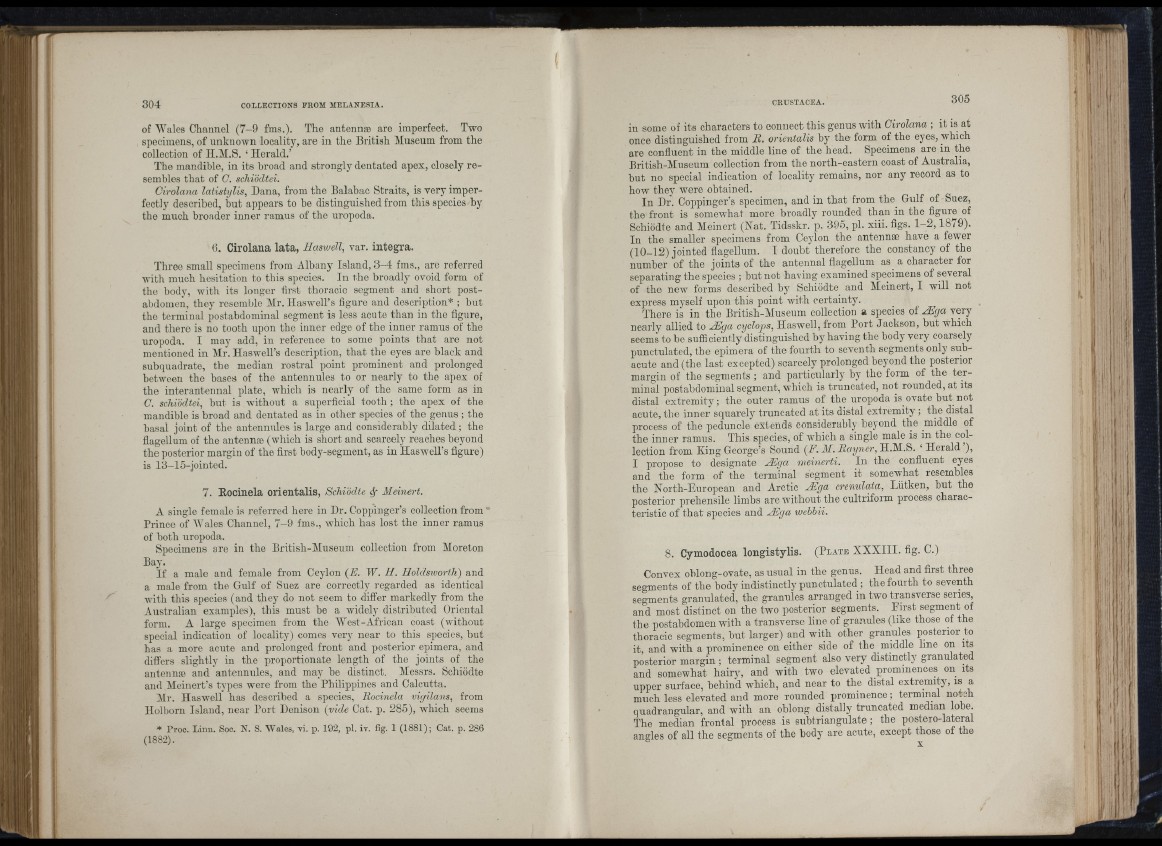
of Wales Channel (7-9 fms.). The antennae are imperfect. Two
specimens, of unknown locality, are in the British Aluseum from the
collection of H.Al.S. ‘ Herald.’
The mandible, in its broad and strongly dentated apex, closely resembles
th at of C. schiodtei.
Cirolana latistylis, Dana, from the Balahac Straits, is very imperfectly
described, but appears to be distinguished from this species by
the much broader inner ramus of the uropoda.
6. Cirolana lata, Hasivell, var. integra.
Throe small specimens from Albany Island, 3 -4 fms., are referred
with much hesitation to this speciea. In the broadly ovoid form of
the body, with its longer first thoracic segment and short postabdomen,
they resemble Air. Haswell’s figure and description* ; but
the terminal postabdominal segment is less acute than iu the figure,
and there is no tooth upon the inner edge of the inner ramus of the
uropoda. I may add, in reference to some points th at are not
mentioned in Air. Haswell’s description, th at the eyes are black and
subquadrate, the median rostral point prominent and prolonged
between the bases of the antennules to or nearly to the apex of
the interantennal plate, which is nearly of the same form as in
C. schiodtei, hut is without a superficial tooth ; the apex of the
mandible is broad and dentated as in other species of the genus ; the
basal joint of the antennules is large and considerably d ilated ; the
flagellum of the antennae (which is short and scarcely reaches beyond
the posterior margin of the first body-segment, as iu Haswell’s figure)
is 13-15-jointed.
7. Eocinela orientalis, Sehiodte Sf Meinert.
A single female is referred here in Dr. Coppinger’s collection from
Prince of AA’ales Channel, 7-9 fms., which has lost the inner ramus
of both uropoda.
Specimens are in the British-Aluseum collection from Moreton
Bay.
I f a male and female from Ceylon {E. W. H. Holdsworth) and
a male from the Gulf of Suez are correctly regarded as identical
with this species (and they do not seem to differ markedly from the
Australian examples), this must be a widely distributed Oriental
form. A large specimen from the AVest-African coast (without
special indication of locality) comes very near to this species, hut
has a more acute and prolonged front and posterior epimera, and
differs slightly in the proportionate length of the joints of the
antennae and antennules, and may be distinct. Alessrs. Sehiodte
and Meinert’s types were from the Philippines and Calcutta.
Air. Haswell has described a species, Eocinela vigilans, from
Holborn Island, near Port Denison {vide Cat. p. 285), which seems
* Proc. Linn. Soc. N. S. Wales, vi. p. 192, pi. iv. fig. 1 (1881); Cat. p. 286
(1882).
in some of its characters to connect this genus with Cirolana ; it is at
once distinguished from E. orientalis by the form of the eyes, which
are confluent in the middle line of the head. Specimens are in the
British-Aluseum collection from the north-eastern coast of Australia,
but no special indication of locality remains, nor any record as to
how they were obtained.
In Dr. Coppinger’s specimen, and in th at from the Gulf of Suez,
the front is somewhat more broadly rounded than in the figure of
Sehiodte and Meinert (Xat. Tidsskr. p. 395, pi. xiii. figs. 1-2 ,1 8 7 9 ).
In the smaller specimens from Cejdon the antenme have a fewer
(10-12) jointed flagellum. 1 doubt therefore the constancy of the
number of the joints of the antennal flagellum as a character for
separating the species ; hut not having examined specimens of several
of the new forms described by Sehiodte and Aleinert, I will not
express myself upon this point with certainty.
There is in the British-Aluseum collection a species of HSga very
nearly allied to J lg a cyclops, Haswell, from Port Jackson, but which
seems to be sufficiently distinguished by having the body very coarsely
punctulated, the epimera of the fourth to seventh segments ouly suhacute
and (the last excepted) scarcely prolonged beyond the posterior
margin of the segments ; and particularly by the form of the te rminal
postahdominal segment, which is truncated, not rounded, at its
distal extremity; the outer ramus of the uropoda is ovate hut not
acute, the inner squarely truncated at its distal extremity ; the distal
process of the peduncle extends considerablj" beyond the middle of
the inner ramns. This species, of which a single male is in the collection
from King George’s Sound (A. Af. H.M.S. ‘H e ra ld ’),
I propose to designate HJeff meinerti. In the confluent eyes
and the form of the terminal segment it somewhat resembles
the North-European and Arctic Hlga crenulata, Liitken, but the
posterior prehensile limbs are without the cultriform process characteristic
of th a t species and HIga ivebhii.
8. Cymodocea longistylis. (P late X X X III. fig. C.)
Convex ohlong-ovate, as usual in the genus. Head and first three
segments of the body indistinctly punctulated ; the fourth to seventh
segments granulated, the grannies arranged in two transverse series
and most distinct on the two posterior segments. First segment ot
the postahdomen with a transverse line of granules (like those of the
thoracic segments, but larger) and with other granules posterior to
it and with a prominence on either side of the middle line on its
posterior margin ; terminal segment also very distinctly granulated
and somewhat hairy, and with two elevated prominences on its
upper surface, behind which, and near to the distal extremity, is a
much less elevated and more rounded prominence; terminal notch
quadrangular, and with an oblong distally truncated median lobe.
The median frontal process is subtriangulate; the postero-lateral
angles of all the segments of the body are acute, except those of the
£
■ i'i '
il 'I
: i (
t e l
l i ,.
, »I
• .1
. . ¡í'(
t ! .1
( Y i .
ill ill
1;;